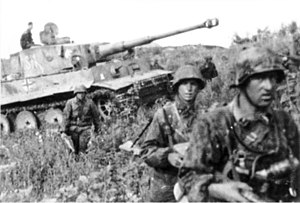Battle of Nagykanizsa: Difference between revisions
No edit summary |
No edit summary |
||
| Line 51: | Line 51: | ||
{{Vasarden Great War Campaignbox}} | {{Vasarden Great War Campaignbox}} | ||
}} | }} | ||
The '''Battle of Nagykanizsa''' was a [[Great War (Vasarden)|Great War]] engagement between [[Granzery|Granzerian]] and [[Vierz Empire|Vierz]] forces on the Eastern Front near Nagykanizsa in Granzery, during July and August 1947. The battle began with the launch of the Granzerian offensive [[Operation Hussar]], on 5 July, with the aim of pinching the Vierz salient around Nagykanizsa with simultaneous armoured thrusts into the north and south of the salient. The Granzerian offensive achieved some initial success on the north salient while the southern offensive stalled. The Vierz forces launched powerful counterattacks on the north and south of the salient, involving armoured and mechanized forces. | The '''Battle of Nagykanizsa''' was a [[Great War (Vasarden)|Great War]] engagement between [[Granzery|Granzerian]] and [[Vierz Empire|Vierz]] forces on the Eastern Front near Nagykanizsa in Granzery, during July and August 1947. The battle began with the launch of the Granzerian offensive [[Operation Hussar]], on 5 July, with the aim of pinching the Vierz salient around Nagykanizsa with simultaneous armoured thrusts into the north and south of the salient. The Granzerian offensive achieved some initial success on the north salient while the southern offensive stalled. The Vierz forces launched powerful counterattacks on the north and south of the salient, involving armoured and mechanized forces which would cut off the Granzerian advance in the Northern salient. | ||
A week after the battle the joint Tierado-Vonzumieran [[Invasion of Sejpedek]] began and the Granzerian offensive was cancelled to divert troops to the new front with the West. The Granzerian People's Army suffered extensive losses in men and tanks during the battle, which was the final Granzerian offensive operation of the war. | A week after the battle the joint Tierado-Vonzumieran [[Invasion of Sejpedek]] began and the Granzerian offensive was cancelled to divert troops to the new front with the West. The Granzerian People's Army suffered extensive losses in men and tanks during the battle, which was the final Granzerian offensive operation of the war. | ||
Revision as of 04:46, 5 April 2020
The Battle of Nagykanizsa was a Great War engagement between Granzerian and Vierz forces on the Eastern Front near Nagykanizsa in Granzery, during July and August 1947. The battle began with the launch of the Granzerian offensive Operation Hussar, on 5 July, with the aim of pinching the Vierz salient around Nagykanizsa with simultaneous armoured thrusts into the north and south of the salient. The Granzerian offensive achieved some initial success on the north salient while the southern offensive stalled. The Vierz forces launched powerful counterattacks on the north and south of the salient, involving armoured and mechanized forces which would cut off the Granzerian advance in the Northern salient.
A week after the battle the joint Tierado-Vonzumieran Invasion of Sejpedek began and the Granzerian offensive was cancelled to divert troops to the new front with the West. The Granzerian People's Army suffered extensive losses in men and tanks during the battle, which was the final Granzerian offensive operation of the war.
